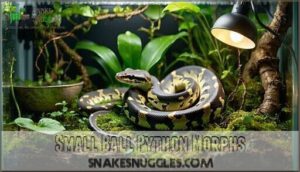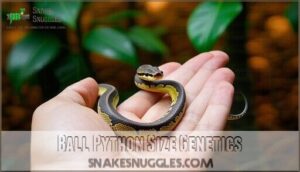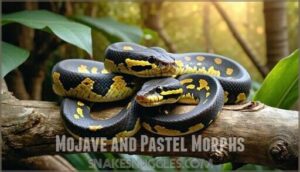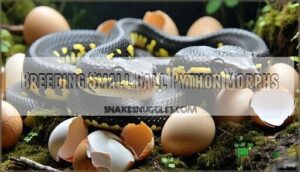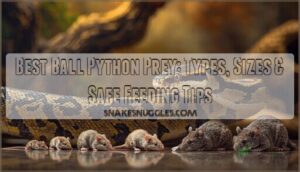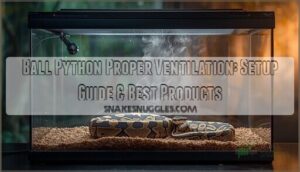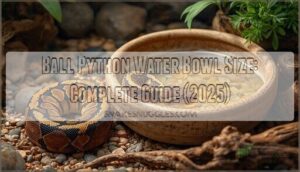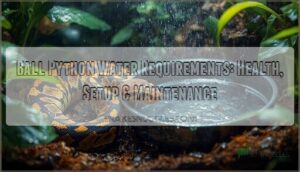This site is supported by our readers. We may earn a commission, at no cost to you, if you purchase through links.
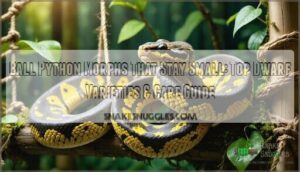
Some morphs, like Super Dwarf or certain locality lines, are bred to stay under three feet as adults.
Their genetics play the biggest role—smaller parents often mean smaller babies.
While most ball pythons average three to five feet, these dwarf morphs are perfect if you want a pet that won’t take up much space.
They need the same care as larger morphs: proper enclosure, heat, and humidity.
Choosing the right morph can make caring for your snake as easy as pie.
Curious which morphs make the shortlist?
Table Of Contents
- Key Takeaways
- Small Ball Python Morphs
- Ball Python Size Genetics
- Popular Small Morphs
- Caring for Small Ball Pythons
- Breeding Small Ball Python Morphs
- Frequently Asked Questions (FAQs)
- What breed of python stays small?
- What is the most sought after ball python morph?
- Can you keep a ball python small?
- Are small ball python morphs more expensive to buy?
- Do small morphs have unique temperament differences?
- Can small morphs be housed with larger snakes?
- What is the lifespan of small ball python morphs?
- Are there special handling tips for smaller morphs?
- Conclusion
Key Takeaways
- You can find ball python morphs, like Super Dwarf and certain locality lines, that naturally stay under three feet thanks to selective genetics.
- Smaller morphs need the same care as standard ball pythons but fit better in limited spaces and require smaller enclosures and prey items.
- Genetics, not feeding or environment, mainly determine your snake’s adult size—breeding small parents usually results in smaller offspring.
- Always house small morphs separately from larger snakes for safety reasons, and remember they can live 20-30 years with proper care.
Small Ball Python Morphs
You’ll find several ball python morphs that naturally stay smaller than standard-sized pythons, making them ideal for keepers with space constraints.
These compact varieties result from specific genetic combinations that affect both size and appearance, offering the same stunning visual traits in a more manageable package.
Dwarf Morphs
Dwarf ball python morphs consistently stay smaller than standard varieties through locality-specific genetics.
Dwarf ball python morphs offer manageable size and unique genetics, perfect for keepers with limited space.
These compact ball python varieties offer three key advantages:
- Space efficiency – Require 20-30 gallon enclosures versus larger setups
- Feeding economy – Consume smaller prey items throughout their lives
- Handling ease – Manageable size for all experience levels
Mini ball python morphs from Togo and Volta bloodlines average 3-4 feet as adults, representing authentic dwarf genetics with slower growth rates but similar health profiles.
Genetic Factors Affecting Size
Behind the scenes of ball python genetics, growth hormones and gene expression work together to determine your snake’s final size.
Genetic mutations in specific mutant alleles can create dwarf ball python varieties that stay smaller than typical morphs.
Size inheritance follows predictable patterns – when you breed small ball python parents, their offspring often inherit these compact traits.
Mini ball python morphs result from these genetic mutations affecting normal growth pathways in snake genetics.
Care and Housing for Small Morphs
Small ball python morphs require adjusted housing that matches their compact size.
You’ll need smaller enclosure size options – a 40-gallon tank works perfectly for most dwarf varieties.
Maintain proper temperature gradient between 78-88°F with humidity levels around 50-60%.
Provide appropriately sized hides and decor that won’t overwhelm your small snake pets.
Choose fine substrate choice materials like cypress mulch for easier movement and better ball python care.
Many owners find supplies for their dwarf ball python online.
Ball Python Size Genetics
You can predict your ball python’s adult size by understanding how genetic traits pass from parents to offspring.
Size inheritance follows the same dominant and recessive patterns as color morphs, with some genes reducing overall growth while others maintain standard dimensions.
You can use this knowledge to better understand how genetic traits will influence your ball python’s size.
Inheritance of Size Traits
Your ball python’s size heritability ranges from 0.2 to 0.6, meaning genetics control roughly 40-60% of adult size variation.
Environmental factors and selective breeding substantially influence growth rate outcomes.
Key inheritance patterns include:
- Size traits follow polygenic inheritance with multiple genes contributing small effects
- Parent-offspring size correlations typically range between 0.3-0.5 in snake breeding
- Gene interactions between morph alleles can modify normal growth trajectories in small python breeds
Role of Dominant and Recessive Genes
Gene expression determines how dominant and recessive genes shape your snake’s size characteristics.
Dominant genes need only one copy to influence growth patterns, while recessive genes require two copies from heterozygous carriers.
Co-dominance creates unique size variations when different mutant alleles interact.
Homozygous traits produce predictable outcomes, making morph genetics essential for understanding ball python morphs and their adult dimensions.
Ethical breeding practices also consider genetic diversity to promote animal welfare.
Gene expression and co-dominance play crucial roles in determining the size characteristics of ball pythons.
Predicting Size in Ball Python Morphs
Predicting your ball python’s adult size requires examining genetic markers from both parents.
Growth rate varies between ball python morphs – some snake morphs reach full size faster than others.
Environmental impact and diet influence final dimensions, but morph genetics remain the primary factor.
Snake size predictions improve when you compare morph characteristics across generations, giving you better control over breeding outcomes, which involves understanding the role of genetic markers.
Popular Small Morphs
If you’re looking for ball python morphs that won’t outgrow smaller enclosures, certain varieties tend to stay more compact than their standard counterparts.
While genetics play the primary role in determining adult size, some popular morphs like Piebald, Albino, and Mojave lines often produce smaller individuals due to selective breeding practices, which can result in smaller individuals.
Piebald Morphs
Three main piebald pattern variations showcase stunning snake morphs with unique Piebald Coloration.
These ball python morphs feature white patches contrasting against normal-colored areas, creating striking small snake morphs.
Piebald Genetics follow simple recessive inheritance, making Piebald Rarity moderate among snake morph identification enthusiasts.
Ideal Piebald Markings display clean white sections with distinct borders, making them highly sought-after specimens.
Many morphs, including pied ball pythons, are available for sale.
Albino and Leucistic Morphs
Albino genetics create stunning leucistic variations through simple recessive inheritance patterns.
You’ll notice visual differences between true albinos with red eyes and leucistic morphs with blue eyes.
These snake morphs showcase remarkable snake colors ranging from pure white to cream with yellow patterns.
Amelanistic traits cause these variations in color.
Breeding challenges include fertility issues in some lines, while ethical considerations focus on avoiding lethal combinations that harm snake health and welfare.
Mojave and Pastel Morphs
Among popular ball python morphs, Mojave and Pastel varieties don’t typically stay smaller than normal-sized pythons.
Mojave morphs display distinctive keyhole patterns with dark coffee-colored bodies and bright yellow blotches.
Pastel morphs showcase blushing brown patches with enhanced coloration.
Key characteristics include:
- Mojave markings feature flame-edged keyhole patterns on dark bases
- Pastel colors show enhanced yellows and reduced dark pigmentation
- Super Pastel morphs display intensified blushing brown coloration
- Both morphs maintain standard ball python size ranges
These snake morphs remain popular choices for small reptile pets due to their striking appearances rather than reduced size.
Caring for Small Ball Pythons
Small ball python morphs require specialized care that differs from their full-sized relatives.
You’ll need to adjust feeding schedules, enclosure dimensions, and monitoring practices to guarantee your compact companion thrives throughout its life, which is crucial for their well-being.
Feeding and Nutrition
Small ball pythons require appropriately sized prey items to prevent choking or regurgitation.
Offer frozen-thawed mice or rats that match your snake’s thickest body section. Feed juveniles weekly, adults every 10-14 days.
Monitor body condition closely since smaller morphs face higher obesity risks. Fresh water should always be available for proper hydration needs.
Avoid supplementation unless veterinarian-recommended. Many owners reliably source pre-killed rodents for consistent feeding to ensure their snakes receive the best possible nutrition, including the right amount of food and proper hydration.
Environmental Enrichment
Your small ball python morphs need proper enrichment to thrive in captivity.
Create habitat complexity with hiding spots, branches, and varying substrate depths.
Mental stimulation comes from rearranging decor monthly and providing textured surfaces for natural behaviors like climbing.
A key element is providing two secure hides within the enclosure.
Snake enclosure safety remains paramount – secure all enrichment types to prevent injury while encouraging exploration in your tiny ball python’s environment.
Health Considerations for Small Morphs
With dwarfism genetics in ball python morphs, you’ll want to watch for unique health considerations.
Here’s what to keep an eye on:
- Feeding challenges—smaller snakes may need smaller, more frequent meals.
- Organ proportionality—organs can be undersized, affecting metabolic rates and lifespan differences.
- Scale mutations and recessive genes—sometimes linked to neurological issues or other genetic complications.
Smaller snakes often require specific ball python food.
Breeding Small Ball Python Morphs
When you breed small ball python morphs, you need to select parents with proven genetics for reduced size.
Careful pairing helps maintain healthy offspring while preserving unique color and pattern traits, which is a complete concept in the breeding process.
Selective Breeding for Size
With careful selective breeding, you can influence ball python morphs’ adult size.
Size-focused breeding and line breeding help pair small snakes, tracking growth rate and morph size correlation over generations.
Always weigh ethical considerations—never sacrifice health for size.
Here’s a quick comparison:
| Method | Focus |
|---|---|
| Size-focused breeding | Smaller adults |
| Line breeding | Consistent traits |
This approach allows for a controlled and consistent breeding process, ensuring the well-being of the snakes while achieving desired traits.
Genetic Diversity in Small Morphs
Your ball python’s genetic diversity shapes morph combinations and future trait inheritance. Morph genetics research shows that gene interactions and mutant alleles affect snake morph diversity.
Keeping a broad gene pool helps maintain healthy lines. A fragmented habitat can lead to a skewed morph ratio and reduced genetic diversity.
Here are five key points:
- Morph combinations boost diversity
- Gene interactions matter
- Trait inheritance isn’t random
- Mutant alleles add variation
- Genetic prediction guides breeding, which is crucial for understanding how gene interactions and mutant alleles impact the snakes.
Breeding Challenges and Considerations
Breeding small ball python morphs requires careful attention to genetic health and ethical practices.
You’ll face fertility issues when working with certain morph combinations, as some genes affect reproductive success.
Inbreeding risks increase when focusing on specific traits, potentially compromising genetic diversity.
Responsible sales mean educating buyers about morph genetics research and health considerations.
Proper morph breeding techniques involve selecting healthy breeding stock and avoiding problematic genetic pairings that could harm offspring welfare.
This approach ensures that breeders prioritize the well-being of the animals, which is essential for ethical practices.
Frequently Asked Questions (FAQs)
What breed of python stays small?
If you want a python that stays small, look at the Children’s python or the Antaresia genus.
These snakes usually reach 2-3 feet, making them easy to handle and fit for most home enclosures.
What is the most sought after ball python morph?
The Banana morph often tops wish lists for its bright yellow and purple colors, but Albino, Piebald, and Blue-Eyed Leucistic morphs are also highly prized.
Each offers unique patterns, making them collector favorites.
Can you keep a ball python small?
Did you know most adult ball pythons reach 3 to 5 feet.
You can’t keep one permanently small. Their size depends on genetics and care.
Feeding less won’t stunt growth safely, so always prioritize their health.
Are small ball python morphs more expensive to buy?
You’ll notice price depends more on rarity, pattern, and color than size.
Smaller morphs aren’t usually pricier just for staying small.
Unique looks or rare genetics tend to drive up the cost, not their adult size.
Do small morphs have unique temperament differences?
You won’t find unique temperament differences based on morph size alone.
Ball python temperament depends more on individual personality and handling than color or pattern.
Just like people, each snake’s attitude can vary, regardless of morph, which relates to their unique characteristics.
Can small morphs be housed with larger snakes?
Mixing small morphs with larger snakes isn’t safe.
Bigger snakes may see smaller ones as food or bully them for space.
You’ll want to house each snake separately to keep stress and injury at bay.
What is the lifespan of small ball python morphs?
Small ball python morphs usually live 20 to 30 years, just like their larger cousins.
With proper care, you’ll see your snake thrive for decades.
Regular checkups, clean habitats, and steady feeding help guarantee a long, healthy life.
Are there special handling tips for smaller morphs?
Over 70% of ball python injuries happen during handling.
Always support your snake’s whole body, use gentle movements, and avoid sudden grabs.
Handle after meals only when fully digested to prevent stress or regurgitation.
Conclusion
Imagine a bookshelf, where each book is a unique ball python morph.
Some books are slim and compact, just like ball python morphs that stay small. By understanding genetics, you can choose morphs that fit your space and care abilities.
Smaller morphs need the same attention to enclosure, diet, and health. With careful selection and proper care, you’ll enjoy a manageable, fascinating pet.
Remember, size is just one chapter in your ball python’s story.

